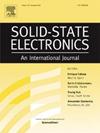SOI和SOS mosfet自热效应比较
IF 1.4
4区 物理与天体物理
Q3 ENGINEERING, ELECTRICAL & ELECTRONIC
引用次数: 0
摘要
在本研究中,我们使用计算机辅助设计(TCAD)数值模拟技术深入分析了在绝缘体上硅(SOI)和碳化硅上硅(SOS)衬底上制造的器件的自热效应(SHE)和传热特性。结果表明,在相同的操作条件下,SOI器件的最大晶格温度升高约为SOS器件的3.9倍,突出了SOS器件优越的热管理性能。当栅极电压为1.8 V时,与SOI器件相比,SOS器件的泄漏电流减少了约27%,表明SOS器件对SHE的抵抗能力增强。通过对热耗散途径的分析可知,对于SOI器件,热量主要通过器件层内的源极区和漏极区消散,而对于SOS器件,由于其高导热性,热量主要通过碳化硅衬底消散,从而显著提高了散热效率。此外,我们的研究揭示了SOI和SOS结构的器件层厚度增加与晶格温度升高之间的相关性。这一现象与热电耦合效应和器件热阻的变化密切相关。本文章由计算机程序翻译,如有差异,请以英文原文为准。
Comparison of Self-Heating effect between SOI and SOS MOSFETs
In this research, we perform an in-depth analysis of the self-heating effect (SHE) and heat transfer characteristics of devices fabricated on silicon-on-insulator (SOI) and silicon-on-silicon carbide (SOS) substrates using technology computer-aided design (TCAD) numerical simulations. The results reveal that, under identical operating conditions, the maximum lattice temperature increase in SOI devices is approximately 3.9 times higher than that in SOS devices, highlighting the superior thermal management properties of SOS devices. When SHE is considered at a gate voltage of 1.8 V, the leakage current in SOS devices decreases by about 27 % compared to SOI devices, demonstrating enhanced resistance to SHE in SOS devices. Analysis of the thermal dissipation pathways reveals that for SOI devices, heat primarily dissipates through the source and drain regions within the device layer, while for SOS devices it predominantly dissipates through the silicon carbide substrate due to its high thermal conductivity, thereby significantly improving thermal dissipation efficiency. Additionally, our research uncovers a correlation between increasing device layer thickness and elevated lattice temperature for both SOI and SOS structures. This phenomenon is closely associated with thermal-electric coupling effects and changes in device thermal resistance.
求助全文
通过发布文献求助,成功后即可免费获取论文全文。
去求助
来源期刊

Solid-state Electronics
物理-工程:电子与电气
CiteScore
3.00
自引率
5.90%
发文量
212
审稿时长
3 months
期刊介绍:
It is the aim of this journal to bring together in one publication outstanding papers reporting new and original work in the following areas: (1) applications of solid-state physics and technology to electronics and optoelectronics, including theory and device design; (2) optical, electrical, morphological characterization techniques and parameter extraction of devices; (3) fabrication of semiconductor devices, and also device-related materials growth, measurement and evaluation; (4) the physics and modeling of submicron and nanoscale microelectronic and optoelectronic devices, including processing, measurement, and performance evaluation; (5) applications of numerical methods to the modeling and simulation of solid-state devices and processes; and (6) nanoscale electronic and optoelectronic devices, photovoltaics, sensors, and MEMS based on semiconductor and alternative electronic materials; (7) synthesis and electrooptical properties of materials for novel devices.
 求助内容:
求助内容: 应助结果提醒方式:
应助结果提醒方式:


